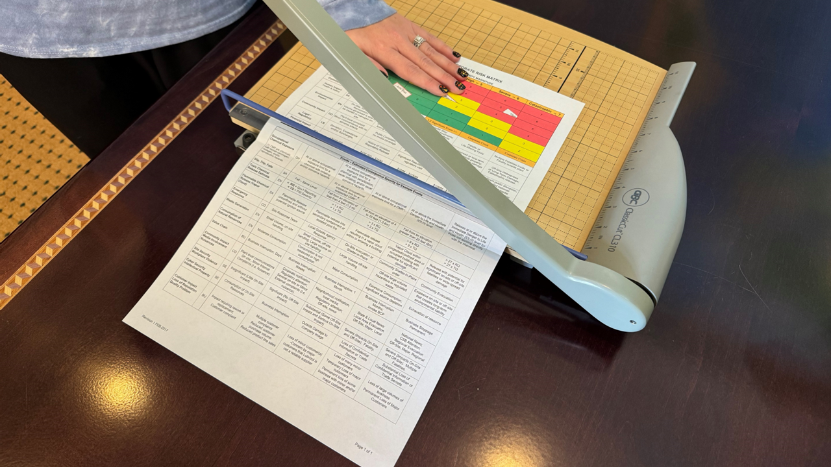“The first cut is the deepest.” — Rod Stewart
Most of our work regards process safety hazards: the potentially fatal hazards involving chemical fires, explosions, and toxic releases. Frequently, our clients also ask for our help with industrial safety hazards: the potentially fatal hazards involving slips, trips, and falls, and contact with objects. Recently, though, a client confronted us with a question about safety hazards in an office environment. “Can you help us there? Our office personnel feel like they’re being overlooked.”
Obviously, there are ergonomic hazards. We’ve discussed those and will discuss them again. And there is the hazard of thermal exposure from spilled coffee. Think of the Liebeck v. McDonald’s case. But then there is that essential element of office work: paper.
Is there anything to be said about paper cuts and paper cutters?
Paper Cuts
We seem resigned to the hazard of paper cuts. They are painful and frequent, but there doesn’t seem to be anything we can do about them.
Paper cuts are painful because they are usually on our fingertips, which are packed with nerves. Paper cuts are not deep, but they are deep enough to slice through dozens of nerve endings. Our nerves’ response to that severing is to scream out to us with pain. Because they aren’t deep, paper cuts don’t bleed much and will usually stop bleeding in an hour or so, and completely heal in a couple of days.
There was recently a piece in Chemical and Engineering News that explained how paper can be such a vicious instrument of excision. It depends on how thick the paper is. If the paper is too thin, it will bow before it is able to push through the epidermis. So, no paper cuts from tissue. On the other hand, if the paper is too thick, force is distributed over too large a surface to tear through the skin. Researchers at the Technical University of Denmark found that “peak cuttability occurs at about 65 μm.” That 20 lb. copy paper stocked in most offices is 0.004 inches (101 μm) thick; a little thicker than peak, but close enough to do the trick. Sixty-pound coated offset paper, as is used when printing journals and magazines, is 0.0027 inches (69 μm) thick; just about perfect for slicing through the skin of a fingertip.
The advice to avoid paper cuts is to use moisturizers, because dry skin is easier to cut. Also, for people who work with paper a lot, consider wearing latex gloves, which serve as a barrier between the cutting edge of the paper and the epidermis.
Can Paper Cuts Be Fatal?
Paper cuts are the epitome of annoying but largely harmless injuries. Most people don’t even bother with first aid. Asking if they can be fatal seems like a silly question. They are certainly not fatal because of blood loss. They can, however, be fatal if allowed to become infected. There is a story about an Australian man who contracted necrotizing fasciitis from a paper cut, although sepsis is a more commonly encountered infection that can, in fact, lead to death. All of which underlines the importance of cleaning the wound and using an antibiotic ointment after getting a paper cut.
What About Paper Cutters?
The fact that the paper cutters or paper trimmers used in an office setting are also called guillotine cutters can be immediately triggering for some people. But are they really dangerous?
OSHA thinks so.
In 1976, only a few years after the founding of OSHA, a team from the Division of Occupational Safety Programming with nothing better to do issued a letter of interpretation about paper cutters.
They invoked the machine guarding regulations, pointing out the general requirement to protect against points of operation.
“29 CFR 1910.212(a)(3)(ii) does not apply only to power operated machinery, equipment and tools but to all equipment with point of operation hazards which may inflict injury on the operator. It is the consensus of the Division of Occupational Safety Programming that 29 CFR 1910.212(a)(3)(ii) being applicable to point of operation hazards, 29 CFR 1910.242 is applicable to the safe condition of hand-operated paper cutters.”
That rod that comes on a paper cutter is a machine guard. As with all machine guards provided by equipment manufacturers, do not remove it. To do so would result in a violation of OSHA regulations.
Paper – A Hazardous Material?
Office environments are low hazard workplaces. So low that most are included in the list of industries exempt from the recordkeeping requirements for Form 300 (Log of Work-Related Injuries and Illnesses), Form 300A (Summary of Work-Related Injuries and Illnesses), and Form 301 (Injury and Illness Incident Report). However, “low hazard” does not mean “hazard-free”. The essence of office work – paper – has hazards associated with it, hazards that have been recognized and that can and should be addressed.
Put a Lid On It
As for hot coffee, the normal temperature for a freshly brewed cup of coffee is in the range of 160 to 190 F. In the plant, we use 140 F is the threshold temperature for thermal exposure. Coffee, that staple of office work, is clearly a hazard for thermal exposure. So, make sure that coffee cups are insulated or provided with sleeves, and provided with lids to prevent spilling as someone carries from the break room to their desk. If nothing else, the janitorial staff will appreciate not having to clean up the spots on the floor.
